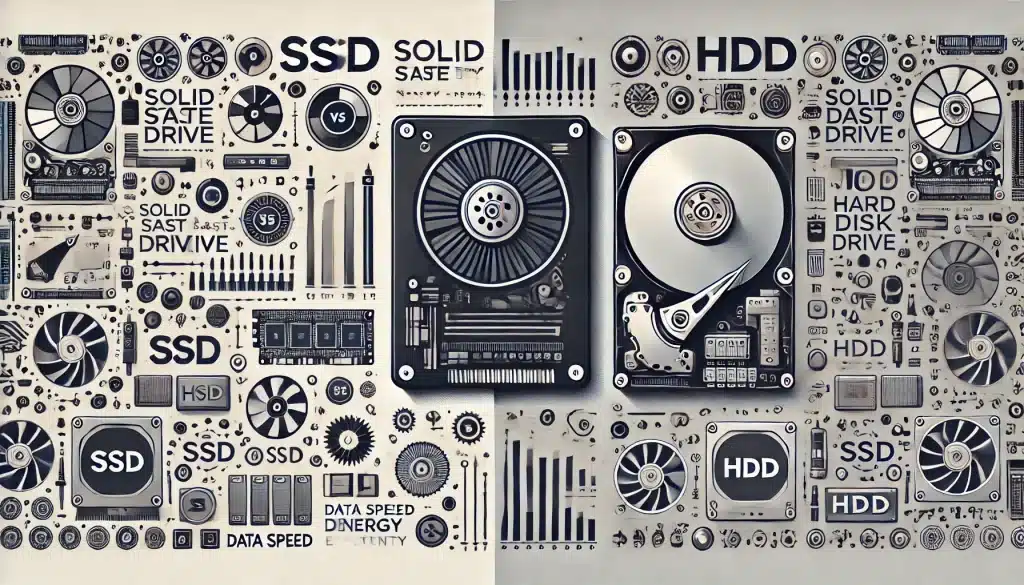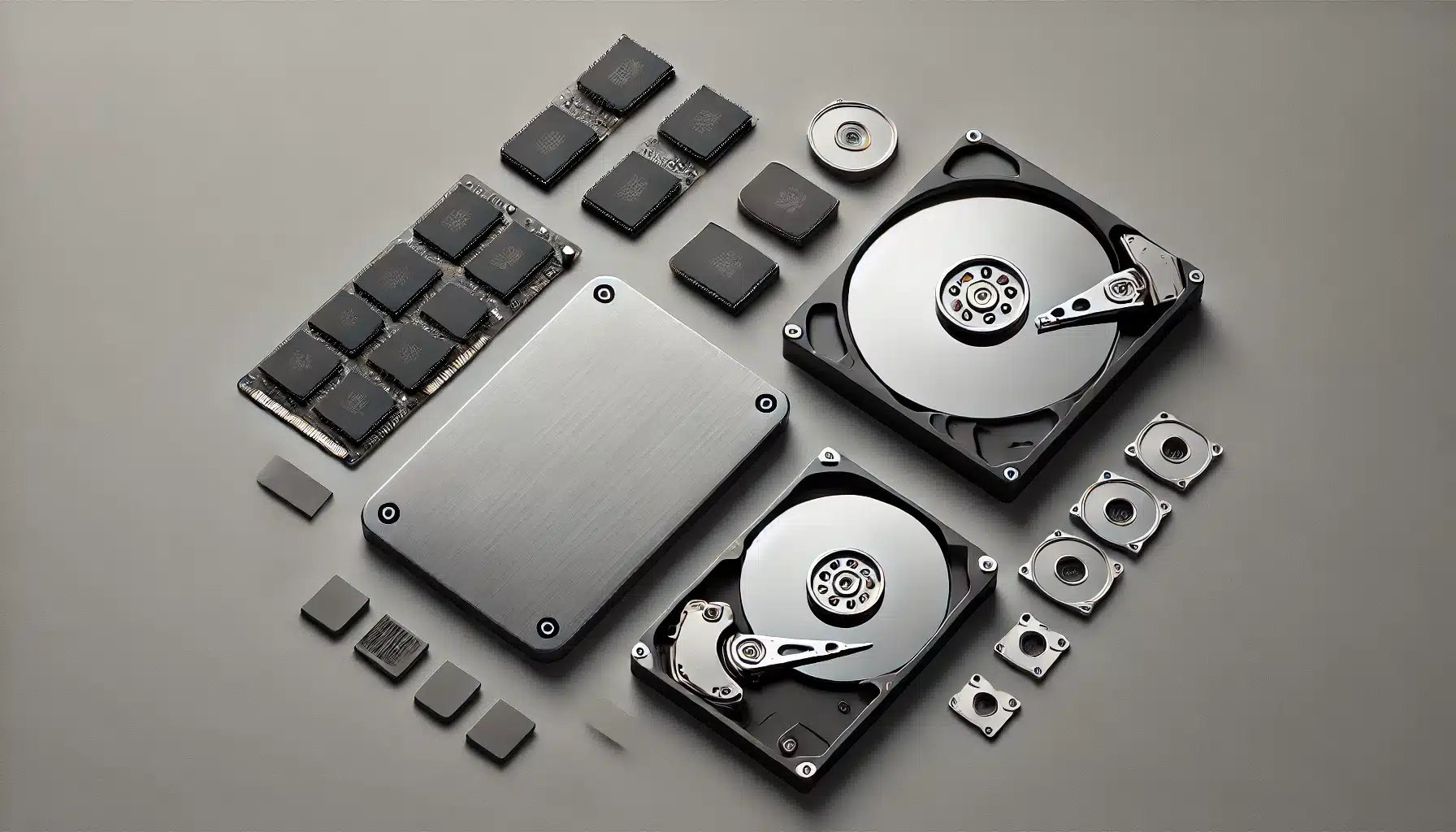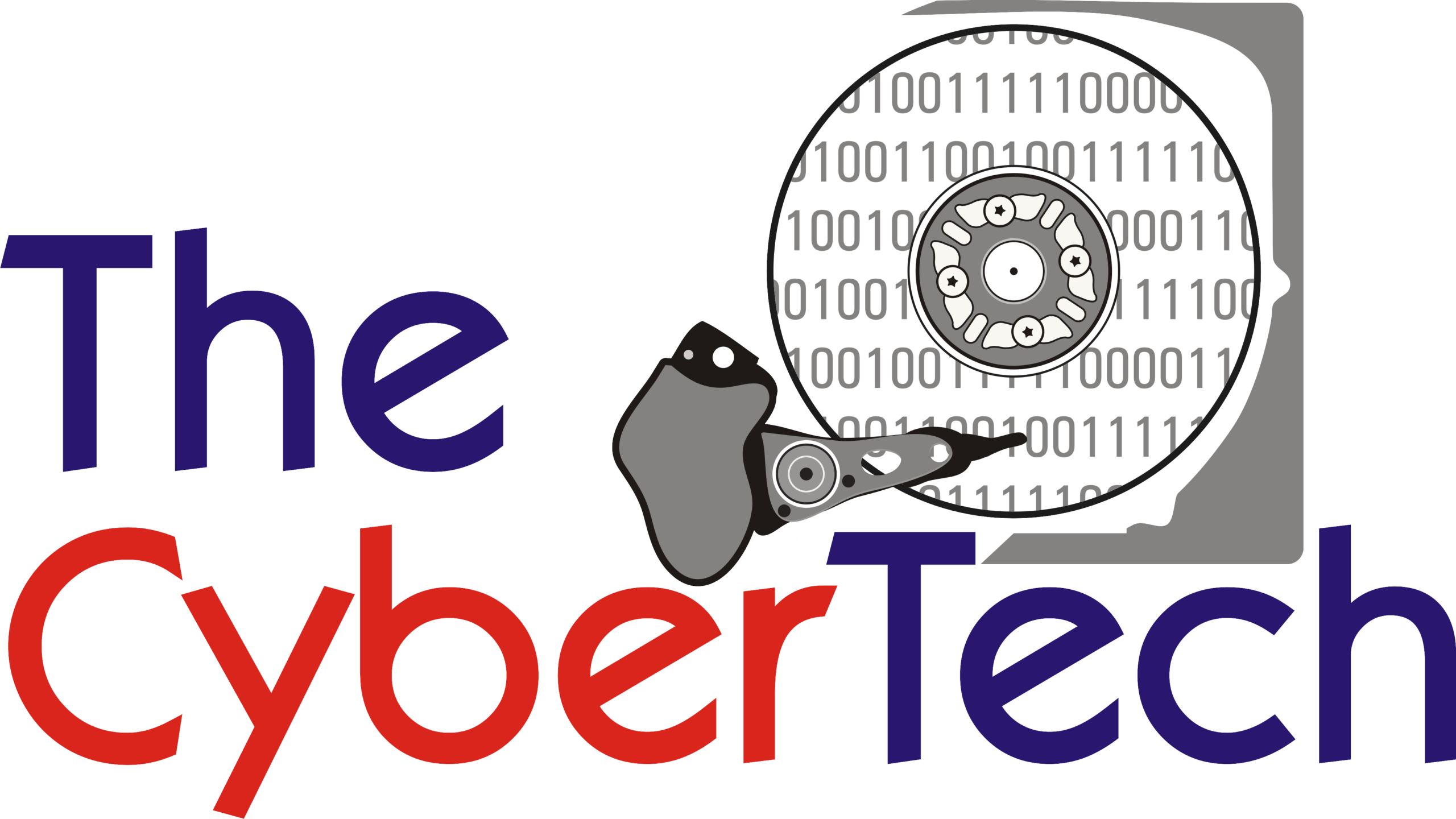SSD vs HDD: Weaknesses, Data Recovery Factors And Failure Rates

In today’s rapidly changing digital world, when it comes to storage technology it can be a dilemma to choose between a Solid state drive(SSD) and a Hard disk drive(HDD). In this article, we’ll untangle the pros and cons of SSD vs HDD, while also delivering important insights into their data recovery capabilities and failure rates.
SSDs and HDDs can vary significantly in terms of performance, cost and durability. While SSDs are faster and costlier, HDDs are less costlier and slower because they use platters which are moved by a motor. However when we talk about choosing between the two for data recovery both present different methodologies.
Also, to evaluate which model is right for your needs, it’s important to know the failure rates of SSDs and HDDs. We will delve into the common reasons for failures and address misconceptions surrounding data recovery for both types of drives.
At the end of this article, you’ll be able to make a conscious decision in order to meet your storage solution needs.
SSD: Strengths and Weaknesses
Strengths
1. Energy effective – SSDs abate the heat and consume low power which helps in saving energy and contribute to longer lifespan in portable gadgets.
2. Performance – SSDs use flash memory technology which helps in obtaining and retrieving data quickly. This makes them perfect for tasks which require constant read and write operations like booting your computer in a shorter time and loading large files quickly.
3. Durability – SSDs have no moving components which makes them less vulnerable to physical damages. Also SSDs are more resistant to shock,vibrations and impact as compared to HDDs.
4. No Noise – As solid state drives involve no moving parts, they operate silently and give more pleasant user experience especially in quiet surroundings.
Weaknesses
1. Higher Cost – SSDs cost relatively higher per gigabyte storage when compared to hdd.Users looking for large storage capacity will look for HDD with the same capacity as the cost of large storage SSD would be significantly higher.
2. Finite Endurance: SSDs can be written only for a limited number of times after which they may start to degrade and fail. In this regard, modern SSDs have significantly improved but users who engage in frequent database updates may need to consider the impact on SSDs lifespan.
3. Storage Capacity – HDD counterparts are much less costly as compared to high storage capacity SSDs this can be a concern for users who are looking for large storage spaces.
4. Recovery of Lost data – The biggest disadvantage of an SSD is it cannot recover lost data in some events which can lead to irreparable consequences.
HDD: Strengths and Weaknesses
Strengths
1. Cost efficient – Hard disk drives offer lower cost per gigabyte of storage as compared to solid state drives which makes them perfect for users who require large storage capacities.
2. Higher storage capacity – HDDs offer up to several terabytes,which allow users to store large data on a single drive.This makes them best suited for applications requiring large storage volumes.
3. Durability – HDDs usually have longer lifespan as compared to SDDs with some models rated for up to 1 million hours of mean time between failures (MTBF). This is especially important for users who look for long term storage solutions for critical data.
4. Practical size and portability – The hard disk drives are usually small in size which is perfect as it can be easily carried from one location to another
Weaknesses
1. Slower Performance – HDDs give relatively slower performance as compared to SSDs. These drives rely on mechanical components which leads to slower data access and transfer speeds.This can be noticed while booting up a computer, launching applications or loading large files.
2. Fragile – Since HHDs involve moving parts they are more vulnerable to physical damage,vibrations and impact which can lead to drive failure. It can be concerning for users who transport their devices frequently and operate them in surroundings with high level physical activity.
3. Higher energy cost – More heat is generated and more power is consumed by an HDD as compared to an SSD which can be a disappointment for users of portable devices or systems with limited cooling capabilities and it can also lead to shorter battery life.
4. Noise – Hard disk drives involve moving parts called platters that are used for read and write operations. While working on a large application these read-write processes vibrate and make sounds which can be very irritating.
Solid State Drives(SSDs) vs Hard Disk Drives(HDDs): What you need to know?

Performance Comparison
Both SSD and HDDs give different experiences when it comes to performance.
SSDs stand out where speed and responsiveness is crucial , while HDDs surpass in cost effective storage capacity. The secret of SSD being ahead is its use of flash memory technology which allows instant data access and retrieval.
SSDs outshine when it comes to faster boot times, application load times and file transfer speed. This makes them favored to users who prioritize snappy system performance such as professionals who work with large files.
In comparison, HDDs rely on mechanical components like spinning platters and read write heads, which can lead to moderate data access and transfer speeds .This can be evident in tasks that require read and write operations frequently. In case, users do not require lightning fast speeds of SSDs, HDDs can still help in adequate performance.
Despite that, it should be noted that the performance gap between SSDs and HDDs has narrowed in recent times, due to the introduction of advanced HDD technologies, such as SSHDs and high speed HDDs.
Cost Comparison
With regards to cost comparison between Solid State Drive (SSDs) and Hard Disk Drive (HDDs), there are some remarkable differences to contemplate.
Primarily SSDs costs higher per gigabyte of storage when compared to HDDs because the manufacturing process of a SSD is more complex and also because it uses flash memory technology. As a result, high capacity SSDs are significantly more expensive than their HDD counterparts.
Advancements in SSD manufacturing and market competition has led to reduction in prices of SSD making them more accessible to a wider range of consumers.
Reliability and Failure Rates
Solid state drives and hard disk drives unveil different characteristics when it comes to reliability and failure rates.
SDDs are more reliable and less inclined to physical damage as compared to HDDs. SDDs have no moving parts which makes them less receptive to failures caused by shock, vibration or impact.
However, SSDs do have a drawback in the form of finite write endurance. Before SSDs begin to degrade and fail, the memory cell can only withstand a certain number of write cycles. Even when modern SSDs have significantly improved users who engage in heavy and continuous write operations need to consider the impact on the SSDs lifespan.
In contrast, HDDs use moving parts due to which they are more exposed to physical damage. HDDs may degrade gradually over time because the mechanical components wear down with prolonged use. It can be defenseless against shock, vibration and impact, which can lead to data loss and drive failure.
Factors such as manufacturing defects, environmental conditions and user usage patterns can all contribute to the unexpected failure of both SSDs and HDDs, in spite of their reliability and failure rates. It is always recommended to have a reliable data backup strategy, regardless of the storage technology being used.
SSD vs HDD: Data Recovery Solutions
When it comes to data recovery, Solid State Drive and Hard Disk Drive present different challenges and methodologies.
Data recovery from a hard disk drive is easy and straightforward as compared to Solid State Drives.
In case of HDD , when you lose data or your drive fails, various techniques for data recovery can be used. To scan the drive for recoverable files, specialized software is used or you can physically access the drive’s internal components to extract the data. HDDs are more responsive to these types of data recovery methods, as the data is stored on physical platters which can be accused and analyzed.
In contrast, data recovery for SSDs can be more complicated. The flash memory technology makes it difficult to access and retrieve the stored data directly. In addition, wear leveling algorithms and encryption further complicates the data recovery process.
In the event of SSD failure or data loss, it is recommended to take help from data recovery experts. Under the guidance of professionals, data recovery for SSDs can be expensive as compared to HDDs but with the necessary tools and expertise data can be extracted from the drive even with complexities of SSD technology.
It is important to note that both HDDs and SSDs can fail without notice so its said to have a backup strategy to minimize the risk of data loss. To improve the chances of recovering your data in the event of a drive failure one must take regular backups to an external storage device or a cloud-based solution.
Factors to consider when choosing between SSD and HDD
When you have to decide between a SSD and HDD for your storage demands, there are several determining factors one must consider ;
Performance : If you want to prioritize speed and responsiveness, SSD is the best option one can choose. SSDs put forward faster boot times, application load times and file transfer speeds remarkably compared to HDDs. This makes them the preferred option for tasks that frequently require read and write operations.
Storage Capacity : HDDs usually offer large storage capacity at a lower cost per gigabyte as compared to SSDs. Someone who requires vast amounts of storage for data archives, media libraries or backup purposes, an HDD may be the more cost effective solution.
Durability : SSDs are usually more durable and unsusceptible to physical damage, as they have no moving parts. This makes them a right choice for portable devices or environments with higher levels of shock, vibration or impact. HDDs, on the other hand, are more open to physical damage due to their mechanical components.
Power Consumption : Since SSDs are less power consuming and generate less heat than HDDs, they can be the priority for users of systems with limited cooling capabilities.
Cost : SSDs are usually more expensive per gigabyte storage as compared to HDDs. The cost difference can vary for users who require large storage capacities.
Lifespan: Both HDDs and SDDs have limited lifespan but SDDS are considered to have longer lifespan with some models rated for up to 1 million hours of mean time between failures (MTBF). However continuous write operations can impact SSDs lifespan.
Future Trends In Storage Technology
In this dynamic world of digital storage the decision to opt between a solid-state drive (SSD) and a hard disk drive (HDD) is a hard nut to crack. Even after determining the pros and cons of each storage technology the decision eventually needs to be taken as per your specific needs and requirements.
If your priority is lightning-fast performance, choosing SSD can be a winning situation as it allows instant data access and retrieval but if storage capacity and cost-effectiveness are your primary concerns, HDDs may be the more suitable option as they offer significantly larger storage capacities at a lower cost per gigabyte.
But it is also important to take into account other factors such as durability, lifespan, power consumption, and data recovery. SSDs are generally more resistant to physical damage and consume less power, while HDDs are more vulnerable to shock and vibration but offer more straightforward data recovery options.
Another marked trend is the rise of hybrid storage solutions which unites the best features of both SSDs and HDDs. Solid-state hybrid drives (SSHDs) merge a small SSD cache with a traditional HDD, resulting in a balance of performance and cost-effective storage capacity. These hybrid solutions are a more affordable alternative to pure SSD systems while still delivering enhanced performance compared to traditional HDDs.
In addition, the arrival of new storage technologies, such as phase-change memory (PCM), resistive random-access memory (ReRAM), and magnetoresistive random-access memory (MRAM), holds the potential to turn the storage landscape upside-down in the future. These innovative technologies work towards the limitations of current storage solutions, offering even faster speeds, higher capacities, and improved energy efficiency.
As these evolution continue to expand, the choice between SSDs and HDDs is likely to become even more meticulous, with users having access to a wider range of storage options that cater to their specific needs and budgets. The future of storage technology assures to be an exciting and dynamic landscape, where the lines between different storage solutions may blur, and new innovations could redefine the way we store and access our digital data.
Conclusion
In the end the decision will depend on your certain needs and priorities.
Regardless of what you choose, it is crucial to have a reliable backup strategy in place to safeguard your data against potential drive failures or unexpected data loss. Regular backups, whether to an external storage device or a cloud-based solution, can provide an invaluable safety net and ensure the continued protection of your digital assets.
By carefully weighing the pros and cons of SSD vs. HDD, and considering your unique storage requirements, you can make an informed decision that will serve you well in the ever-evolving digital landscape.
Recent Posts
- 10 Precautions Before RAID Rebuild in NAS or Server
- Linux vs Windows : Which is the best operating system for your dedicated server?
- SSD vs SAS vs SATA Drives: Which is better for your dedicated server hardware?
- RAID Servers and Data Protection: Common Myths about RAID Servers
- Top 8 Do’s and Don’ts when Dealing with a Corrupted SD Card
Recent Comments
- Suresh Gupta on Recovering Lost Data: Understanding the Importance of Server Data Recovery
- Priya Reddy on Recovering Lost Data: Understanding the Importance of Server Data Recovery
- Keyla O. X. Rocha on SSD vs HDD: Weaknesses, Data Recovery Factors And Failure Rates
- Ryker J. F. Hubbard on SSD vs HDD: Weaknesses, Data Recovery Factors And Failure Rates
- Prime Biome Reviews on RAID Servers and Data Protection: Common Myths about RAID Servers
Categories
Categories
- Data Recovery (3)
- Data Recovery Services (4)
- Linux vs Windows (1)
- RAID Data Recovery Services (2)
- SD Card Data Recovery (1)
- Server Data Recovery (4)
- Solid State Drive (3)

